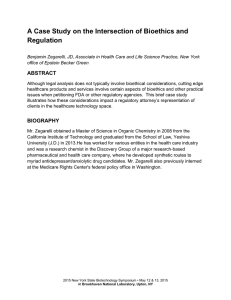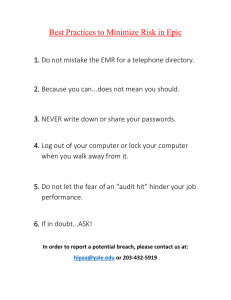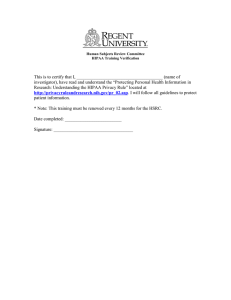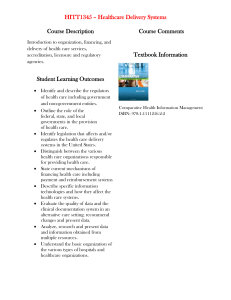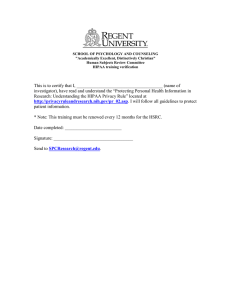Comprehensive Final Study Guide, HCMT 200, F10 Dr. Benson First
advertisement
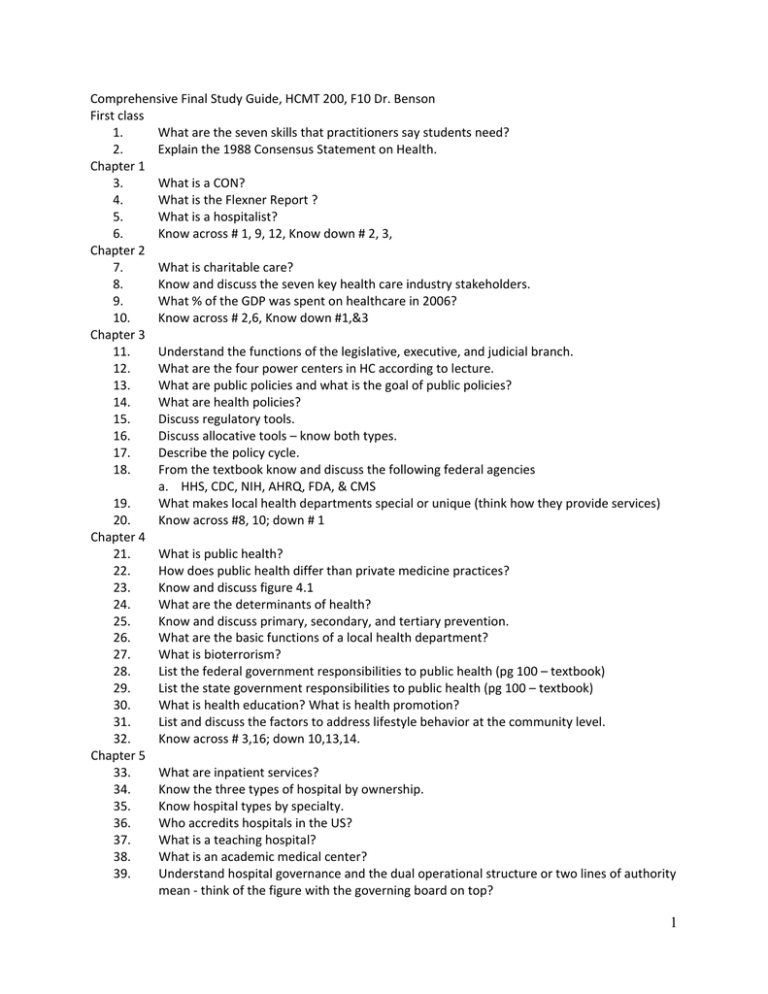
Comprehensive Final Study Guide, HCMT 200, F10 Dr. Benson First class 1. What are the seven skills that practitioners say students need? 2. Explain the 1988 Consensus Statement on Health. Chapter 1 3. What is a CON? 4. What is the Flexner Report ? 5. What is a hospitalist? 6. Know across # 1, 9, 12, Know down # 2, 3, Chapter 2 7. What is charitable care? 8. Know and discuss the seven key health care industry stakeholders. 9. What % of the GDP was spent on healthcare in 2006? 10. Know across # 2,6, Know down #1,&3 Chapter 3 11. Understand the functions of the legislative, executive, and judicial branch. 12. What are the four power centers in HC according to lecture. 13. What are public policies and what is the goal of public policies? 14. What are health policies? 15. Discuss regulatory tools. 16. Discuss allocative tools – know both types. 17. Describe the policy cycle. 18. From the textbook know and discuss the following federal agencies a. HHS, CDC, NIH, AHRQ, FDA, & CMS 19. What makes local health departments special or unique (think how they provide services) 20. Know across #8, 10; down # 1 Chapter 4 21. What is public health? 22. How does public health differ than private medicine practices? 23. Know and discuss figure 4.1 24. What are the determinants of health? 25. Know and discuss primary, secondary, and tertiary prevention. 26. What are the basic functions of a local health department? 27. What is bioterrorism? 28. List the federal government responsibilities to public health (pg 100 – textbook) 29. List the state government responsibilities to public health (pg 100 – textbook) 30. What is health education? What is health promotion? 31. List and discuss the factors to address lifestyle behavior at the community level. 32. Know across # 3,16; down 10,13,14. Chapter 5 33. What are inpatient services? 34. Know the three types of hospital by ownership. 35. Know hospital types by specialty. 36. Who accredits hospitals in the US? 37. What is a teaching hospital? 38. What is an academic medical center? 39. Understand hospital governance and the dual operational structure or two lines of authority mean ‐ think of the figure with the governing board on top? 1 40. 41. 42. 43. 44. 45. Chapter 6 46. 47. 48. 49. 50. 51. 52. 53. 54. 55. 56. 57. 58. 59. 60. 61. 62. Chapter 7 63. 64. 65. 66. 67. 68. 69. 70. 71. 72. 73. 74. 75. 76. 77. Who licenses hospitals? What is outpatient care/ambulatory care? Know the 8 examples of outpatient care settings – pgs 120‐121. What is respite care? What is hospice care? What is adult day care? The JC ???? health care organizations? Know 11 & 12 across, 2 down. Describe the employment future for health care professionals. Physicians control about _% of spending Know and discuss licensure, certification, & registration. Compare primary care physicians to specialists. Compare a DO to a MD. Compare the three types of physician practice styles. What physician specialties are considered primary care? What type of medicine does an OD, DPM, DC and DDS /DMD practice? Which group of health care workers is called the hearts and hands of medicine? What are the two levels of nursing? Compare an RN to a LPN Discuss NP’s and PA’s, What is the value of NPP’s (NP & PA)? Know RD, LT, OT, PT, ST, SW, from lecture for allied health personnel. What skills do health care administrators need? Be able to recognize every type of provider in Chapter 6. Know across #9, 13, Know down # 1, 6, and 11. Know healthcare spending by type. What is health insurance, how is health insurance different from other types of insurances? Know what services BC pays for, what services BS pays for. What is employer‐provided health insurance? What is group insurance? What is social insurance? What is self‐insurance or self‐funded program? What is cost sharing? What is cost shifting? Understand deductible, co‐pay, and co‐insurance? Compare comprehensive health insurance to catastrophic health insurance. What is payer mix? Know what Medicare Part A, Part B, & Part D covers. Medicare is Title ____; Medicaid is Title ___ of the Social Security Act. Who is eligible for Medicare, who is eligible for Medicaid? What are third party payers? Know, understand, and recognize examples of fee for service, retrospective reimbursement, prospective reimbursement, and capitation. Know what services DRG, RBRVS, APC, RUG, & HHRG pay for. Know across #8, #11, Down #9. 78. 79. Chapter 8 80. What is managed care – know and discuss. 81. Remember the definition of managed care the professor gave ‐ combining delivery and financing of health care? 82. What is gatekeeping? 2 83. Be able to recognize the three types of utilization review? 84. Know, understand, discuss, and recognize HMO, PPO, & POS managed care plans. 85. Know down #7, 5, across #2. Chapter 9 86. What is medical informatics? 87. Know what an EHR is? Know what an EMR is? 88. Discuss four benefits to an EMR/EHR. 89. What is a CDSS? How does it help healthcare organizations? 90. What is a CPOE? 91. What is telehealth, telemedicine? 92. Know across #12, #15, down #7. Chapter 10 93. What is law, what is common law? 94. What are statutes? What are rules and regulations? 95. Know and recognize the five types of legal structures of HC organizations. 96. What is a public organization? 97. Know civil law, torts, and criminal law. 98. What is medical malpractice? 99. Describe EMTALA 100. What is the purpose of anti‐trust laws. 101. How does the Clayton Act of 1914 relate to HC organizations? 102. What is informed consent? 103. Discuss the reasonable patient standard and the reasonable physician standard. 104. Discuss the Patient Self‐Determination Act of 1990. 105. What are the patient bill of rights? 106. What are advance directives. 107. Know DNR, Living will and Durable/medical power of attorney. 108. Discuss the Stark laws. 109. Know across # 6,12,17; down# 3, 7. Chapter 11 110. What is bioethics? What is medical ethics? 111. Know and recognize a health care ethical dilemma. 112. Discuss a stakeholder. 113. Know and discuss the healthcare stakeholder management model. 114. Know and discuss the five basic values that all healthcare providers should observe (pg 249). 115. What are cloning, genetic testing, and euthanasia? 116. Know across # 4,9, Know down # 3, 7, Chapter 12 117. What is a mental disorder? 118. How many Americans suffer from a mental disorder in any one year? 119. What is a phobia? 120. Know the following mental health professionals – psychiatrists, social workers, and psychologists. 121. Know and understand Figure 12.1 122. What is the mental health commitment law? 123. What is DSM? What is its purpose? 124. List four barriers to mental health services? 125. Know the 4 most common types of mental disorders (pg 274‐275). 3 126. Depression affects which gender more? 127. What is PTSD? 128. Know 4 alternative approaches to mental health care. 129. Know down #1, #5, across 6. Chapter 13 130. Why is the US health care system complicated? 131. How is funding distributed in most cases? 132. Why are outpt services more cost effective? 133. What type of service is the preferred method of receiving HC services? 134. About how many HC workers are there in the US? 135. How will the aging of the population affect HC workers? 136. What is projected to happen to government programs in HC? 137. Why must consumers and managers know HC law. 138. Why will medical and bioethics gain in importance? 139. What is a code of ethics? 140. Discuss P4P & VBP 141. What is e‐prescribing? How can e‐prescribing increase pt safety? HIPAA 142. What is HIPAA? 143. What is the intent of HIPAA? 144. What is health insurance portability? 145. What is health insurance accountability? 146. What is and give examples of protected health information. 147. What are some punishments for HIPAA violations? Medical Coding 148. What is the coding process? 149. What is ICD‐9 coding and what is it used for? 150. What is CPT‐4 coding and what is it used for? Epidemiology 151. Define epidemiology. 152. What is the purpose of epidemiology? 153. Define mortality and the type of statistics. 154. Define morbidity and the type of statistics. 155. Define endemic, epidemic, and pandemic. 156. Define agent & host. Holistic Medicine 157. What is holistic medicine? 158. What is alternative medicine? What is complementary medicine? 159. Know, discuss, and give examples of each type of complementary medicine. International Health 160. What is mortality, morbidity, infant mortality? 161. What is an infectious disease? What are the Big Three infectious diseases that are responsible for half of the mortality in the developing world? 162. What is a chronic disease? 163. Understand single payer concept, universal access, national health insurance, compulsory insurance, and socialized medicine. WSJ, Acronyms, & ACA questions. 164. To be announced. 4
